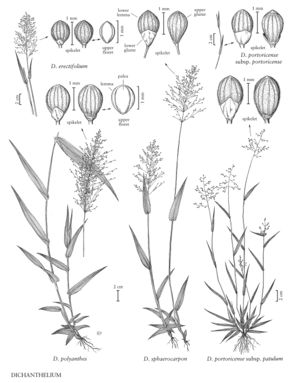Difference between revisions of "Dichanthelium polyanthes"
FNA>Volume Importer |
FNA>Volume Importer |
(No difference)
| |
Revision as of 21:28, 16 December 2019
Plants cespitose, with few culms per tuft. Basal rosettes well-differentiated; blades 3-8 cm long, often to 2 cm wide, ovate-lanceolate. Culms 30-95 cm, nearly erect, fairly stout; nodes glabrous or puberulent; internodes usually glabrous; fall phase with few, long-ascending branches, sparingly rebranched, branches arising mostly near the base of the culms. Cauline leaves 4-7; sheaths shorter than the internodes, mostly glabrous, margins ciliate; ligules vestigial; blades 10-25 cm long, 14-25 mm wide, thick, firm, often light green, veins evident (some more prominent than others), bases cordate, with papillose-based cilia, margins whitish, cartilaginous. Primary panicles 7-20 cm, less than 1/2 as wide as long, exserted. Spikelets 1.3-1.7 mm, broadly ellipsoid-spherical, often purplish at the base, puberulent. Lower glumes 0.4-0.7 mm, acute to obtuse, upper florets 1.1-1.4 mm, broadly ellipsoid, blunt. 2n = 18.
Discussion
Dichanthelium polyanthes grows in woods, stream banks, and ditches, and is restricted to the eastern United States. It occasionally hybridizes with D. sphaerocarpon.
Selected References
None.
